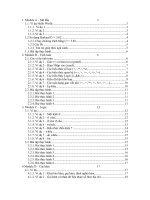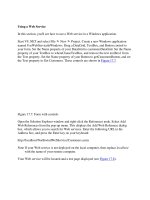Tài liệu Creating a ForeignKeyConstraint Object doc
Bạn đang xem bản rút gọn của tài liệu. Xem và tải ngay bản đầy đủ của tài liệu tại đây (23.5 KB, 3 trang )
Creating a ForeignKeyConstraint Object
The ForeignKeyConstraint constructor is overloaded as follows:
ForeignKeyConstraint(DataColumn parentDataColumn, DataColumn childDataColumn)
ForeignKeyConstraint(DataColumn[] parentDataColumns,
DataColumn[] childDataColumns)
ForeignKeyConstraint(string constraintName, DataColumn parentDataColumn,
DataColumn childDataColumn)
ForeignKeyConstraint(string constraintName,
DataColumn[] parentDataColumns, DataColumn[] childDataColumns)
ForeignKeyConstraint(string constraintName, string parentDataTableName,
string[] parentDataColumnNames, string[] childDataColumnNames,
AcceptRejectRule acceptRejectRule, Rule deleteRule, Rule updateRule)
where
• parentDataColumn and parentDataColumns are the DataColumn objects in the
parent DataTable.
• childDataColumn and childDataColumns are the DataColumn objects in the
child DataTable.
• constraintName is the name you want to assign to the ConstraintName property of
your ForeignKeyConstraint.
• parentDataTableName is the name of the parent DataTable.
• parentDataColumnNames and childDataColumnNames contain the names of the
DataColumn objects in the parent and child DataTable objects.
• acceptRejectRule, deleteRule, and updateRule are the various rules for the
ForeignKey-Constraint.
Earlier in the section "Creating a UniqueConstraint Object
," you saw a code example that
created two DataTable objects named customersDT and ordersDT. The following
example creates a ForeignKeyConstraint object on the CustomerID DataColumn of
ordersDT to the CustomerID DataColumn of customersDT:
ForeignKeyConstraint myFKC =
new ForeignKeyConstraint(
"ForeignKeyConstraintCustomersOrders",
customersDT.Columns["CustomerID"],
ordersDT.Columns["CustomerID"]
);
ordersDT.Constraints.Add(myFKC);
Notice that the ForeignKeyConstraint is added to ordersDT using the Add() method.
N
ote To successfully add a ForeignKeyConstraint to a DataTable, each DataColumn
value in the child DataTable must have a matching DataColumn value in the parent
D
ataTable.
The next example retrieves the constraint just added to ordersDT and displays its
properties:
myFKC =
(ForeignKeyConstraint)
ordersDT.Constraints["ForeignKeyConstraintCustomersOrders"];
Console.WriteLine("myFKC.AcceptRejectRule = " + myFKC.AcceptRejectRule);
Console.WriteLine("Columns:");
foreach (DataColumn myDataColumn in myFKC.Columns)
{
Console.WriteLine("" + myDataColumn);
}
Console.WriteLine("myFKC.ConstraintName = " + myFKC.ConstraintName);
Console.WriteLine("myFKC.DeleteRule = " + myFKC.DeleteRule);
Console.WriteLine("RelatedColumns:");
foreach (DataColumn relatedDataColumn in myFKC.RelatedColumns)
{
Console.WriteLine(""+ relatedDataColumn);
}
Console.WriteLine("myFKC.RelatedTable = " + myFKC.RelatedTable);
Console.WriteLine("myFKC.Table = " + myFKC.Table);
Console.WriteLine("myFKC.UpdateRule = " + myFKC.UpdateRule);
This example displays the following output:
myFKC.AcceptRejectRule = None
Columns:
CustomerID
myFKC.ConstraintName = ForeignKeyConstraintCustomersOrders
myFKC.DeleteRule = Cascade
RelatedColumns:
CustomerID
myFKC.RelatedTable = Customers
myFKC.Table = Orders
myFKC.UpdateRule = Cascade
N
ote You'll find all the code examples shown in this section and the previous section,
"Creating a UniqueConstraint Object," in the AddConstraints.cs program. The
listing is omitted from this book for brevity.









